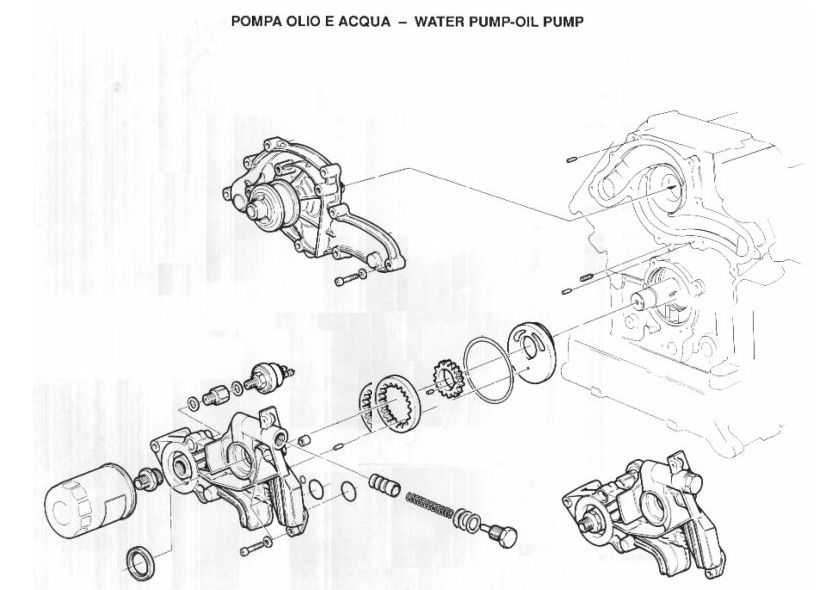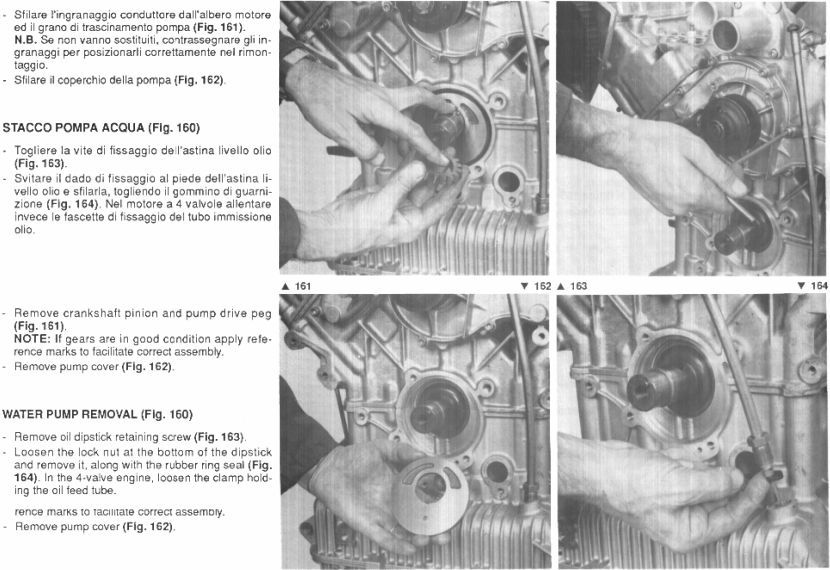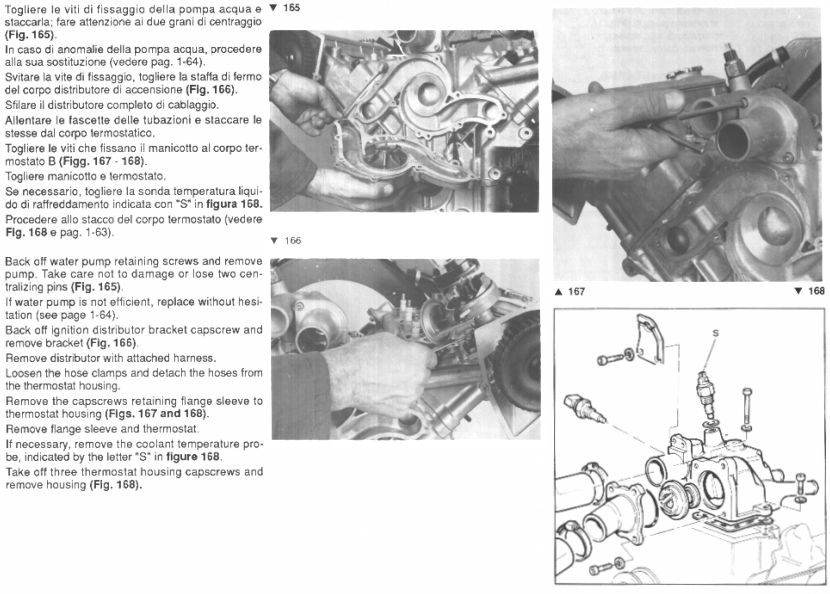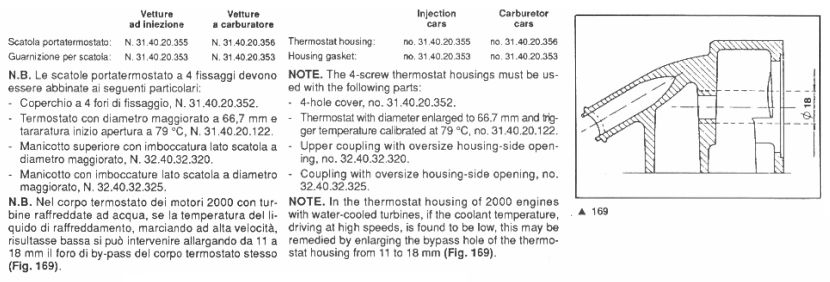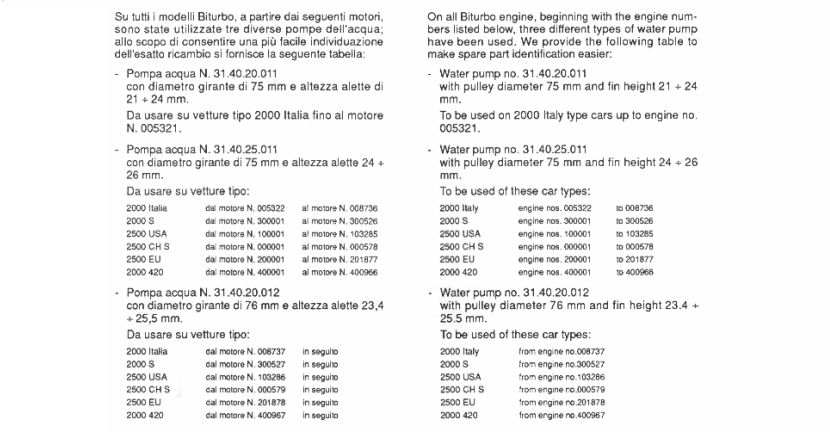My Biturbo isn't feeling very well.
Can you help? Please! |
| |
|
Any owner having a problem with their Maserati can send me details and I will publish these, together
with any subsequent advice I receive, on this page.
Just drop me a line at maserati123@btopenworld.com |
| |
Even if I don't succeed in helping you with your problems; and I do try, it would help other Maserati owners a great deal if you could let me know how you managed to solve your problems. THANK YOU!
|
| |
| |
 |
| |
Bryan in the USA writes:- |
| |
Re: Biturbo.
"Hello,
My name's Bryan and I'm in the US. I'm trying to help my friend on fixing a problem with his Biturbo and I had a question about the oil pressure light on an '83 model. After the car has warmed up the oil pressure light goes on and off and I was wondering if it was the oil pump or if there's something else that could possibly be causing it to be doing this. And, if it is more than likely the oil pump that needs replacement, where is it located and how hard is it to get to.
I appreciate the help.
Bryan." |
| |
 |
| |
Another reply from Andy:-
|
Re: 83 Biturbo.
"Chances are that the oil pressure light sender has failed rather than any problem with the oil pump. If the oil pressure gauge itself is showing good pressure then this would confirm that there is no serious problem. You can change the oil sender (which is combined for the gauge and the light and next to the oil filter) or maybe you just have a poor connection to the back of the sender.
Andy." |
| |
| |
 |
| |
| |
Cristi in ? writes:- |
| |
Re: Biturbo.
"Hello,
I was wondering if you can help me about my 1983 Maserati Biturbo.
A year ago I bought a Biturbo and I restored it completely, but now I have some trouble with the engine. It's not a very bad trouble but I want to ask you something.
When I accelerate the engine over 3000 rpm it's interrupting. Even I if try to accelerate more the engine interrupting more. This does not happen all the time, just when the engine is hot, after I travel 20-30 miles.
Please let me know if you can help me and I will tell you more about my problem, and if you want I can send you some pictures with my Biturbo before and after restoration.
Thank you very much and ahve a nice day.
P.S.
I want to ask you if there is a problem because I've changed the exhaust system replacing the exhaust with two exhaust like the model from "84-'85. Every three cylinder with his exhaust.
Thank you very much.
My best regards." |
| |
 |
| |
Another reply from Andy:-
|
Re: 83 Biturbo.
"There are a number of possibilities here. In order of ease of checking:
1. Have you changed the spark plugs recently and are they in good condition?
2. Have you changed the rotor arm or checked it?
3. Have you checked the condition of the magnetic ignition pick up in the distributor?
If all of the above are beyond suspicion:
4. Have you checked whether there is a fuel pressure problem?
5. Have you checked the valve clearances?
All or any of the above could cause this problem... but no, not likely to be due to the exhaust system you have fitted.
Andy." |
| |
| |
 |
| |
| |
? in Canada writes:- |
| |
Re: Biturbo S.
"I'm from Toronto CANADA, having problems with my new clutch and pressure plate. The guys in Seattle Washingtom M.I.E said to take the lip off the flywheel, so I did but now there is play between the throw-out bearing and the pressure plate
resulting in no clutch.
Two other Biturbo owners told me to put washers in between the flywheel and the pressure plate hold down bolts to create a gap, to release some spring tension.
Does this sound right cause it sounds all funny to me?
Please help!!!!!" |
| |
 |
| |
Another reply from Andy:-
|
Re: Biturbo S clutch.
"Machining the flywheel alone should not give you the problem you are describing - unless you have taken a great deal of thickness away, in which case the first problem you would get is that the clutch centre plate would foul on the flywheel bolts - presume this is not happening?
When you bolt up the new clutch centre and pressure plates, what does the diaphragm look like? Is it relatively flat? (which is good). It is adjustable using washers as you have described but we have never had to do this on a Biturbo (shamal yes). If the diaphragm is flat, you should look elsewhere either in the hydraulics or the clutch fork itself (which commonly cracks/bends/breaks/punches the centre out on the pivot).
You describe play between the throwout and pressure plate - this is odd anyway as the slave cylinder should take out any play when assembled, which also suggests a hydraulic/fork problem. Hope this helps.
Andy." |
| |
| |
 |
| |
| |
Glen in the USA writes:- |
| |
Re: Biturbo.
"I HAVE A 1984 USA MODEL BITURBO. DO I USE NORMAL UNLEADED GAS OR WHAT?" |
| |
 |
| |
Reply from Enrico:-
|
Re: Biturbos and unleaded fuel.
"Hi Glen,
Thank you for your e-mail.
All Biturbos have aluminium heads and should therefore have hardened valve stems. Personally I would use unleaded fuel and if possible add a well-known branded addetive to be on the safe side. For European cars It is essential that the fuel has a rating of 98 RON, however the US models with their stricter emission controls may only require a 95 RON rating.
Best regards,
Enrico." |
| |
| |
 |
| |
| |
Erik in Norway writes:- |
| |
Re: Biturbo ES.
"Hello again Enrico!
Im having a problem with my 86 Biturbo ES.
Everthing has been working fine, until now.... (it had to come;) ) I was driving on the highway about 175kmt when i suddely heard small explosions in the exhaustsystem. The engine didnt respond to trotthling over about 3000RPM.
The engine starts and works fine, but when i push the trottle the engine just makes a kinda "choking" sound, and starts to give small explosions in the exhaustsystem.. I thoght this might be the distrubutor, so i changed this, this afternoon, but still no respons.. No black smoke is coming out of the exhaust either, so i dont think any turbos has broken. Is there anyone out there who can help me with this? Is this a ignition problem, or something worse?
Best Regards,
Erik." |
| |
| |
 |
| |
| |
Paolo in Spain writes:- |
| |
Re: 1985 Biturbo S.
"Hello, my name is Paolo.
I'm Italian but since 1997 I'm living in the south of Spain. Some months ago I bought a 1985 Biturbo S. The engine sounds good, everything works except the turbos pressure. The pressure gauge never goes up to the yellow zone, remaining more or less at 90° to the left of the scale.
Only few days ago I bought in Italy a 1989 422, really perfect. Everything working perfectly, including the turbo pressure, with the indicator reaching normally the yellow zone. But in my return travel from Italy ( I made 1700 km driving continuously during 13 hours, stopping only every 200km to fill up the tank, maybe has been too much), I started loosing sometimes the turbo pressure.
After a night stopped, the day after in the last part of the travel (only 300 km), everything was working right, but as for my Biturbo S, now the pressure doesn't arrive to the yellow zone and the engine have lost the turbo push. The indicator moves more in the 422 but never enters the yellow zone.
I leave in an area were doesn't exists any mechanic who is able to put hand in these engines.
Can you help me?
Can you tell me what happened and what can I do to repair my cars?
Thank you in advance.
Paolo." |
| |
 |
| |
Another reply from Erik in Norway:-
|
Re: Biturbo boost pressure.
"Hi,
I read the tread about the turbo pressure on Paolo’s Biturbo S and 422. I just come to think of the connector plug on the AMAL-valve. I know of a Spyder owner that drove for one year without high boost and no mechanic found the problem. We told him to connect the plug, and the car was a rocket again!!!
Try to check this first!!!
Kind Regards,
Erik." |
| |
 |
| |
Reply from Andy:-
|
Re: Biturbo boost pressure.
"Hi,
This could be a long one! The most common cause of loss of boost is a split or loose pipe between the turbo and the plenum chamber - Not always easy to see.
If everything is OK, you may be losing pressure because the knock sensor is telling the engine to boost less. Are you using premium petrol? If there is knock in the engine, it will compensate. This could be the case anyway after a particularly long and hard run. Next, are you sure the gauge is accurate? There is a small vacuum pipe to the gauge which sometimes splits. Check this. Next, you could have a seized wastegate (mostly seize open which gives you too much boost, but sometimes closed) which is venting the boost. This you can check on the side of the turbochargers - again not easy to see. The arm should spring back and you should hear the wastegate clank against it's seat. Try all these and come back to us!
Andy." |
| |
Reply from Rossano:-
|
Re: Biturbo boost pressure:
"Hi Paolo,
The problem with your boost pressure coud be due to several causes. First you must check all the hoses and tubes (see diagram) carrying the turbo pressure in the system for any possible leaks. After a few years the hoses may crack or split. Also, oil can sometimes enter the system and cause hoses to 'slip off' the tubes. Any leaks would result in poor boost pressure.
Anothe cause could be the failure of the wastegate valve to open/function properly. Another reason could be a damaged turbocharger, but this cannot be confirmed without removing the turbochargers and disassembling them.
TURBOCHARGERS SHOULD ONLY BE WORKED ON BY SPECIALISTS!
Does black smoke exit from the exhaust pipes when the turbochargers are not working properly?
Cheers,
Rossano." |
| |
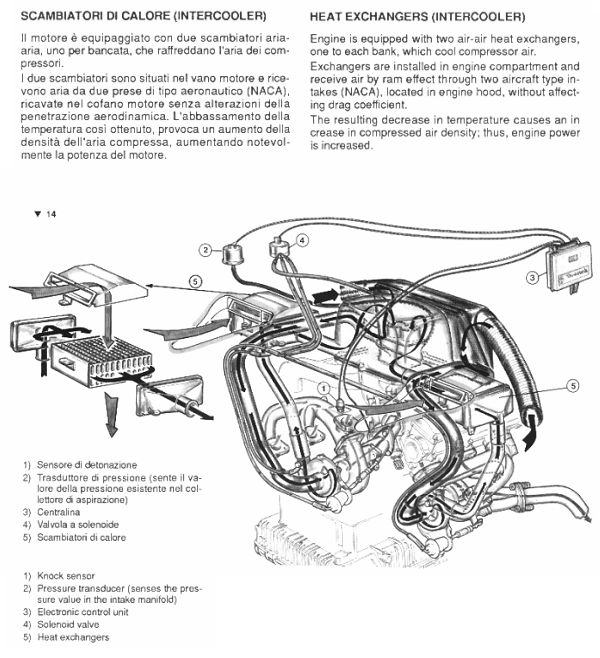 |
| |
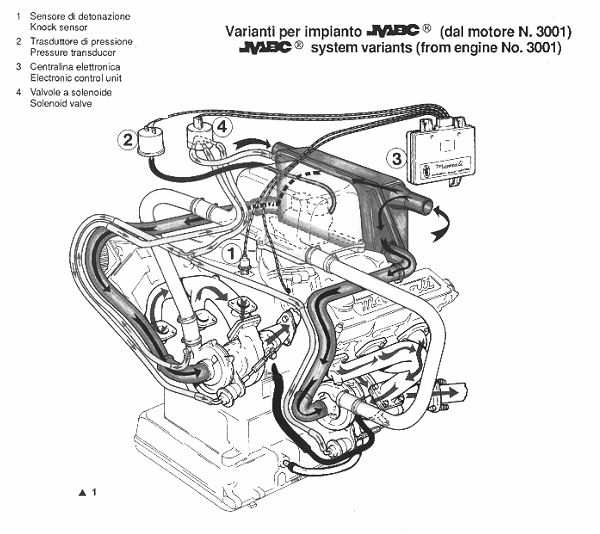 |
| |
| |
| |
 |
| |
| |
Nick in Malaysia writes:- |
| |
Re: Biturbo firing order.
"Hey Bro,
We just completed an engine rebuild on the Biturbo 2.5....just finishing up...just wondering what's the firing order for this engine ???
Pretty hard to work around this car without a workshop manual.
Please get back to me soon. Cheers mate.
Nick.." |
| |
 |
| |
Reply from Enrico:-
|
Re: Biturbo firing order.
"Hi again Nick,
I have attached a page from the workshop manual containing the relevant information.
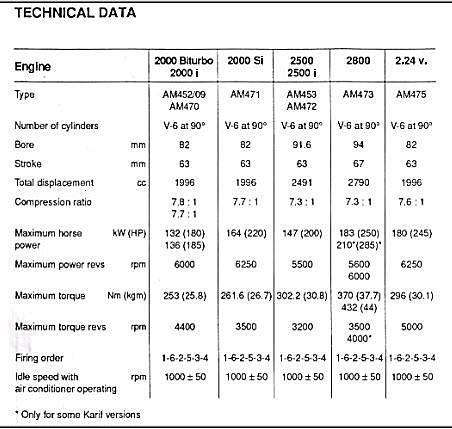
I have the workshop manual for all Biturbo models, 18-valve and 24-valve engines, available on CD-rom. If you want one, let me know.
Hope this helps,
Enrico." |
| |
| |
 |
| |
| |
HELPFUL INFORMATION from Jarle in Norway:- |
| |
Re: Biturbo used parts.
"Hello!
Once again, thank you for a great site.
There is one thing I have been wondering about. Do you know David Askew?
In Europe there are not to many people selling used Maserati parts, but he does. He has a lot of really good used parts, and he is also a 100% trustworthy and nice fella! He is my major parts supplier, and has saved me from HIGHLY expensive repairs several times.
I know for sure a lot of people do not know of him, and I truly feel he is a huge resource for the Maserati community.
web.onetel.net.uk/~davidaskew/maserati/
Anyway, just wanted to tell you so.
Sincere greetings,
Jarle." |
| |
| |
 |
| |
| |
HELPFUL INFORMATION from Henri in France:- |
| |
Re: Biturbos:
"Hello, my name is Henri ******* and I'm living close to Nice on the French Riviera. I've owned 5 Biturbos and this is a suggestion which could help a lot of people.
We faced many electrical problems and they often stem from the relays. I should say they come from the fuses which are mounted on the relays. Those fuses are made of some kind of metallic conductor maintained on a piece of "steatit" and pinched between 2 small blades on the relay itself. It turns out that when many amps are flowing thru the fuse and the relay, the 2 contacts between the fuse and the 2 blades mentioned above are heating. This is simply Ohm's Law consequence and should not hurt. But, when a contact begins to heat, it gets oxided and its resistance increases. This in turn increases the heat dissipated on the contact ..... and so on.... But this is more tricky than that. When heating, the steatit stuff begins to melt and the pressure between the fuses and the blades decreases ; and the contact resistance increases. You always end up with an open but with a fuse which looks good.
So my suggestion is: replace all the relays which are housing a steatit fuse by new relays with a fuse also, but the new ones which have fuses made with 2 spade lugs.
If you are reluctant to replace all of them, do the following first: Check for relays which have their small translucid cover slightly burned on each side of the fuse contacts. If the cover is burned or melt, it's because the contact resistance is too high and it will fail soon. I would be surprised if you dont have at least one or two relays like this on you car; the headlights, the fuel pump, the blowers for instance.....
Best regards,
Henri." |
| |
| |
 |
| |
| |
Durran in the UK writes: |
| |
"My Biturbo has eaten two of these sensors that Charles in France has had a problem with. They are the blue headed little sensor that screws into the domed aluminium housing in the front middle of the engines "vee". From Maserati these cost £64.50 plus VAT (as of Sept 03). Via your local Webcon stockist (in my case Southern Carburettor in London) these are £6.28 plus
VAT. The part number to quote is WTS114. This is a replacement listing for the original. In the mean time a sensor robbed off a scrapped early Alfa 164 V6 will work. Cold running is a little bit lean but bearable.
Maserati also quoted me about £65 for rear brake pads. My local factor supplied a set of Ferodo pads at £16 plus VAT. It looks like an alternative is Alfa 75 front pads although I cannot verify this.
My problem currently is trying to establish what the rear calipers are common with if anything, also
if the fitting kit (springy bit and pins) is common with anything else...
Can anyone help?
Cheers,
Durran." |
| |
| |
 |
| |
| |
Eric in the USA writes: |
| |
"I have a 1984 Biturbo; the vacuum through fitting that goes from the carburettor, through the base of the plenum chamber (or intake manifold as it were), to the vacuum advance needs to be replaced, and I can't for my life find a replacement....HELP!!!
I have never seen the underside of the plenum, however, this weekend I am going to open it up to adjust the carburettor and I will shoot a digital pic then.
Anyway, here's the part; installed, and by itself.
It is an M10 diameter metric bolt with 1.50 metric threads. |
| |
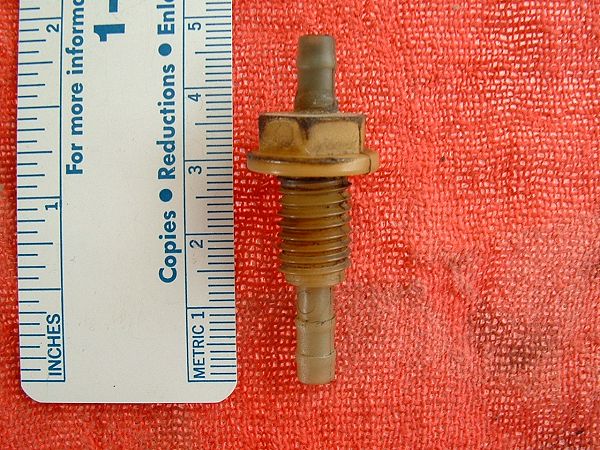 |
| |
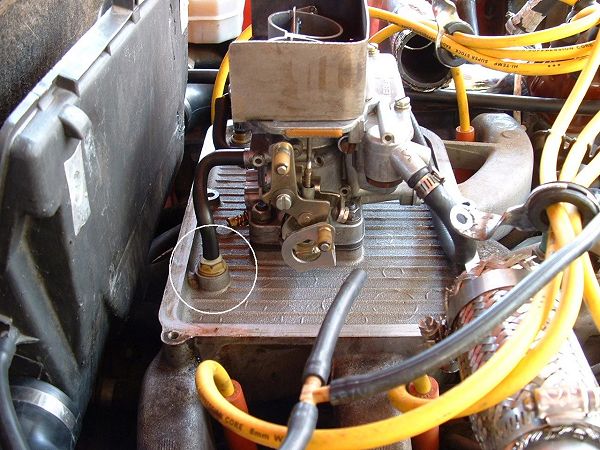 |
| |
Eric." |
| |
| |
 |
| |
| |
Charles in France writes: |
| |
"Hi Enrico,
Your website is really great and I see new pages sometimes!
Now that it has cooled off I am having problems with cold starting and have to remove the water temp sensor connector to force a rich condition so it will start. Once started I reconnect the sensor and it is fine. I suppose what I really need is the fuel injection manual with the sensor specs and idle adjustment procedure unless you have a quick idea what else it may be.
Thanks!
Charles." |
| |
 |
| |
Reply from Rossano:-
|
Re: Biturbo 'cold starting'!
"Enrico,
If the water temperature sensor is damaged in any way, it sends out a false signal to the electronic injection control unit to enrich (increase the fuel content in) the fuel/air mixture. When the engine is cold, this richer fuel/air mixture will 'choke' the engine and it won't start. I would first try replacing the water temperature sensor. Also try CAREFULLY cleaning out the throttle body and the contacts of all the sensors and the potentiometer on the intake manifold. There are no sensor specifications indicated in the workshop manual.
PLEASE NOTE - The function of the electronic injection control unit is to receive information on:
- the absolute air pressure in the intake manifold;
- the temperature of aspirated air;
- the engine coolant temperature;
- the camshaft position;
- the engine speed;
- and the knock sensor.
Rossano." |
| |
| |
 |
| |
| |
Pierino in Australia writes: |
| |
"Carissimo Enrico,
I have Biturbo 1987 and has a problem of water leaking from the water pump.
Can you help, by sending me via email, some photo from a workshop manual, so that I will have some idea of what to do?
I am a retired aircraft engineer and should be able to do it but with some indication and warning of possible problem.
Awaiting your help yours faithfully.
Pierino." |
| |
 |
| |






